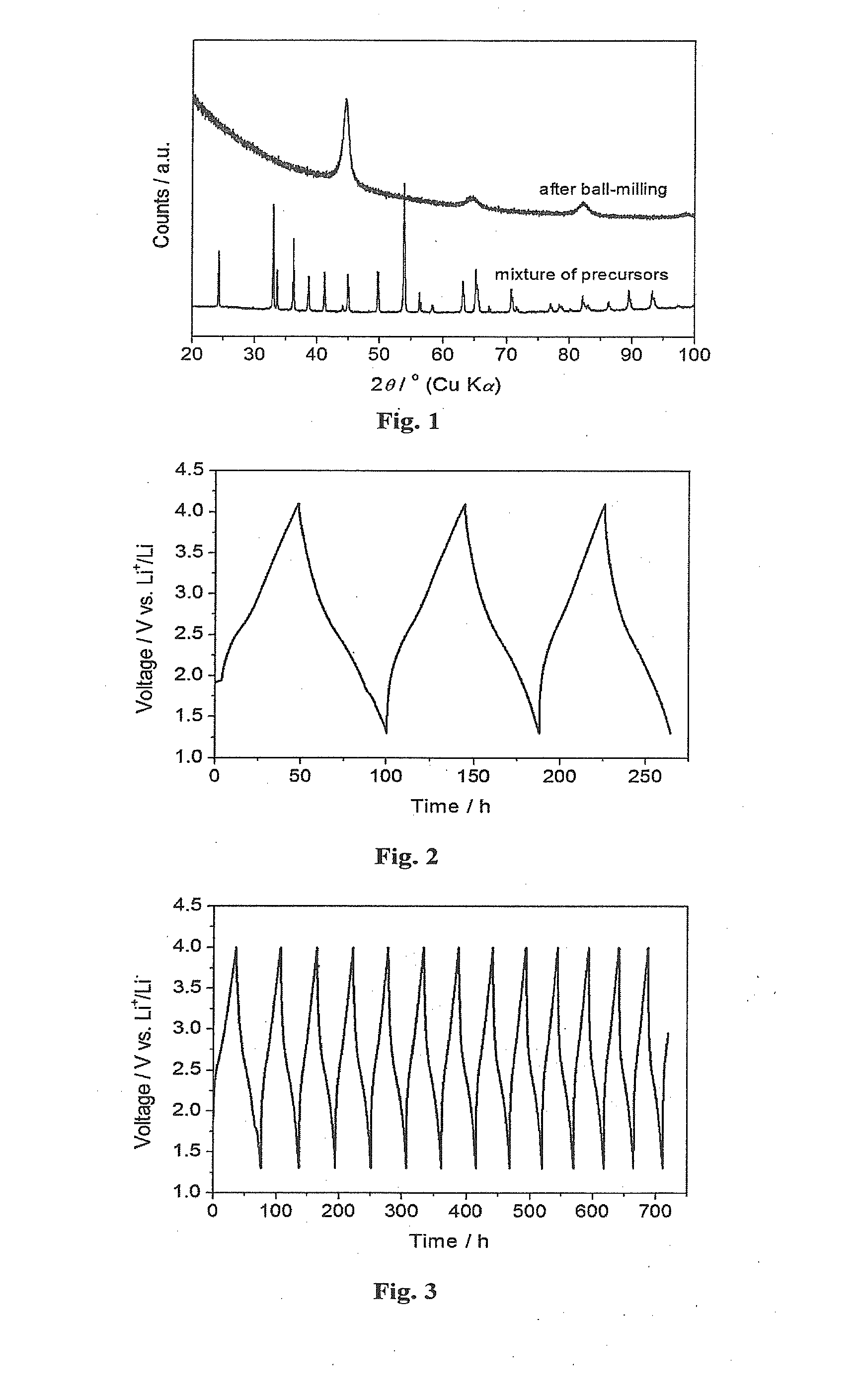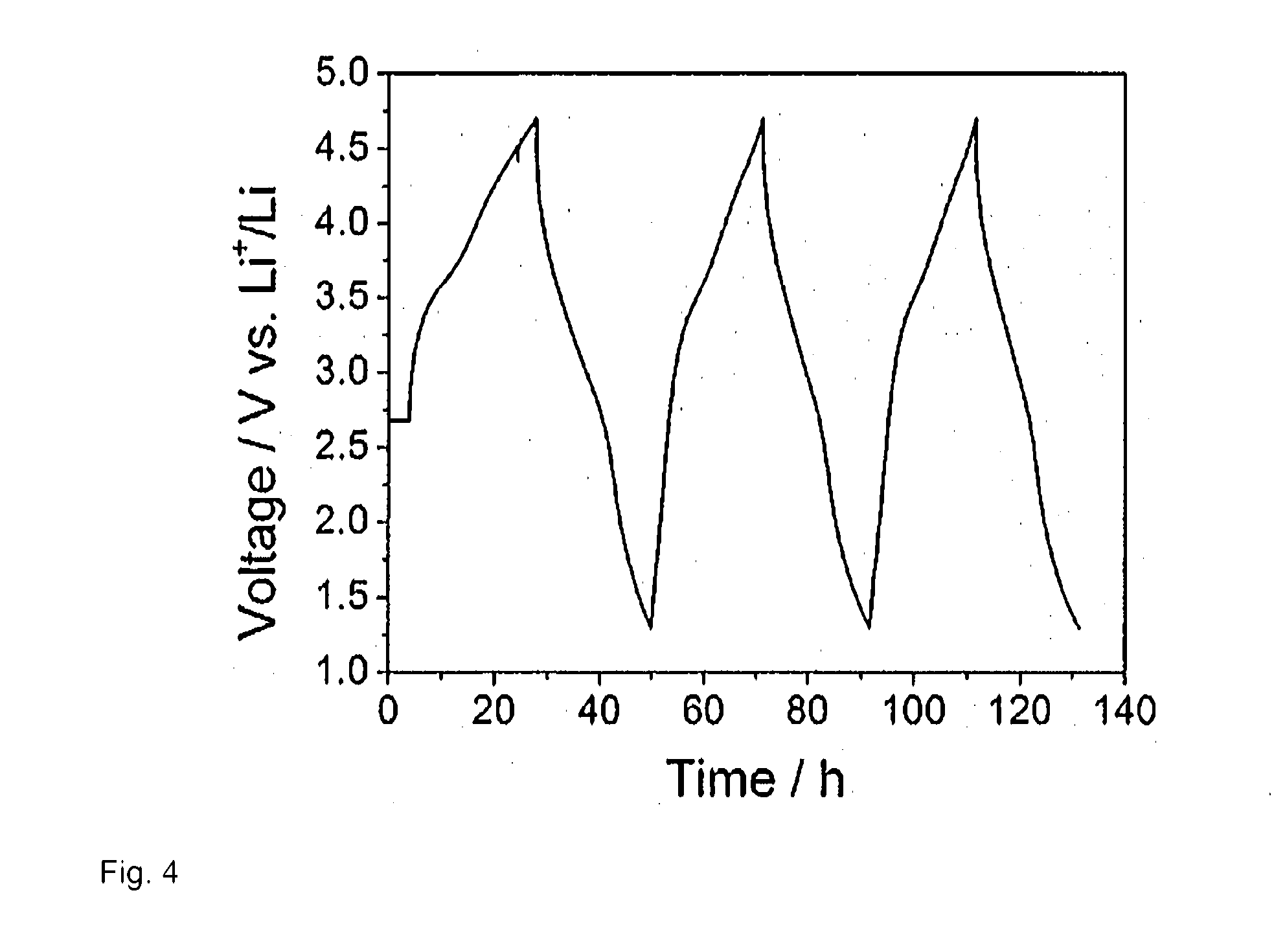Oxyfluoride compounds for lithium-cells and batteries
a technology of lithium-cells and compounds, applied in the direction of cell components, vanadium compounds, electrochemical generators, etc., can solve the problems of battery system design, vanadium oxide, lithium vanadate,
- Summary
- Abstract
- Description
- Claims
- Application Information
AI Technical Summary
Benefits of technology
Problems solved by technology
Method used
Image
Examples
example 1
[0079]0.5188 g LiF, 0.298 8 g Li2O and 1.499 g V2O3 powders were mixed together, placed in a gas-tight container in an argon-filled glovebox and subsequently ball-milled at 450 rpm for 50 h to obtain Li2VO2F.
[0080]FIG. 1 shows the X-ray diffraction patterns for the starting mixture and ball-milled Li2VO2F. The sharp diffraction peaks from the starting precursors disappeared and new phase with broad diffraction peaks were formed after ball-milling. The crystallite size is about 9 nm, calculated by Scherrer equation.
[0081]As-obtained Li2VO2F powders were mixed with carbon black (4:1 w / w) by ball-milling at 200 rpm for 5 h.
[0082]Electrochemical tests were performed using a Swagelok-type half-cell setup using lithium as counter electrode, two sheets of glass fiber as separator and 0.7 M lithium bis(oxalato)borate in ethylene carbonate / diethyl carbonate (7:8 w / w) as electrolyte.
[0083]FIG. 2 shows the galvanostatic charge / discharge performance tested between 1.3 and 4.1 V versus lithium a...
example 2
[0085]0.4928 g LiF, 0.2838 g Li2O, 0.0420 g NaF, 0.0530 g Na2CO3 and 1.499 g V2O3 powders were mixed together, placed in a gas-tight container in an argon-filled glovebox and subsequently ball-milled at 450 rpm for 24 h to obtain Li(1.9)Na(0.1)VO2F.
[0086]As-obtained Li(1.9)Na(0.1)VO2F powders were mixed with carbon black (4:1 w / w) by hand-grinding. Eletrochemical tests were performed using the similar procedure as described in Example 1.
[0087]FIG. 3 shows the galvanostatical charge / discharge performance tested between 1.3 and 4.0 V versus lithium at a current rate of 7.23 mA / g at 25° C.
[0088]The initial discharge capacity was 290 mAh g1. Li(1.9)Na(0.1)VO2F shows excellent cycling stability over further cycling.
example 3
[0089]0.9805 g LiF, 0.06 125 g Li2O and 1.499 g V2O3 powders were mixed together, placed in a gas-tight container in an argon-filled glovebox and subsequently ball-milled at 450 rpm for 20 h to obtain Li2VO(1.6)F(1.8). As-obtained Li2VO(1.6)F(1.8) powders were mixed with carbon black (4:1 w / w) by ball-milling at 250 rpm for 4 h. Electrochemical tests were performed using the similar procedure as described in Example 1.
[0090]Galvanostatic charge / discharge was performed between 4.1 and .1.3 V versus lithium at a current rate of 7.17 mA / g at 40° C. The initial discharge capacity was 170 mAh / g.
PUM
 Login to View More
Login to View More Abstract
Description
Claims
Application Information
 Login to View More
Login to View More - R&D
- Intellectual Property
- Life Sciences
- Materials
- Tech Scout
- Unparalleled Data Quality
- Higher Quality Content
- 60% Fewer Hallucinations
Browse by: Latest US Patents, China's latest patents, Technical Efficacy Thesaurus, Application Domain, Technology Topic, Popular Technical Reports.
© 2025 PatSnap. All rights reserved.Legal|Privacy policy|Modern Slavery Act Transparency Statement|Sitemap|About US| Contact US: help@patsnap.com


